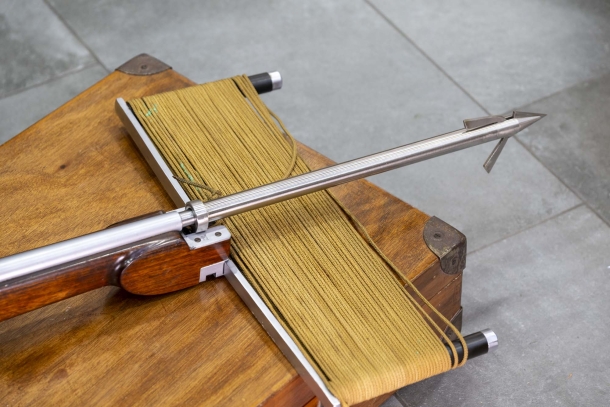W.W. Greener Light Harpoon Gun Mk.2: the star from the movie “Jaws”!
Manufactured in England by W.W. Greener, the Light Harpoon Gun Mk.2 based on a Martini-Henry action gained its place in the Hall of Fame when it appeared in the seminal movie Jaws
W.W. Greener is one of the oldest and most famous firearm manufacturers in Great Britain; established in 1829 by William Greener in Newcastle and moved to Birmingham in 1844, the company – named after the founder’s son, William Wellington Greener – is still today active in the manufacturing of fine hunting rifles and shotguns.
Both William Greener and his son William Wellington Greener were keen inventors, and their work provided important contributions to the fields of engineering and technology far beyond the world of firearms. As far back as 1837, the company had already started to manufacture a line of harpoon throwers for industrial fishing, scientific exploration and capture of marine animals for research purposes.
The first Greener harpoon gun were small cannon-like concoctions that used black powder for propulsion and would be mounted to the bow of whaling ships; in 1890, however, W.W. Greener introduced their first shoulder-fired “Light Harpoon Gun” based on the Martini-Henry rifle action – a design that the W.W. Greener company mastered for decades, manufacturing dozens of shotguns and rifles based on the Martini-Henry falling block design, from hunting and sporting guns to the “Greener Police Gun” shotgun used by colonial police forces all through the British Empire from 1922 onwards. Indeed, W.W. Greener didn’t cease to manufacture firearms based on the Martini-Henry action until 1998.
The second incarnation of the Greener Light Harpoon Gun – aptly dubbed the Mk.2 – came in the 1950s and was manufactured in Birmingham even after the gun-making branch of W.W. Greener was acquired by Webley & Scott in 1965. Webley & Scott marketed the Light Harpoon Gun Mk.2 until they left the firearms business in 1979 and a newly-independent W.W. Greener discontinued it.

W.W. Greener’s Light Harpoon Gun Mk.2 is a relatively simple Martini-Henry action derivative, largely manufactured out of steel and brass. All metal components were hard-chromed to resist corrosion in the humid, salty seafaring environments, and the peculiarly designed handguard and standard Martini-Henry style walnut stock were heavily varnished for the same reason.


The Light Harpoon Gun Mk.2 can be stripped in two assemblies and stored in a dedicated transport case. The rear assembly is essentially an unmodified Martini-Henry stock and action, while the front portion features all the peculiar modifications necessary for a harpoon launcher.
More specifically, the gun is chambered to fire a dedicated blank cartridge that provides propulsion, developed specifically by Kynoch from .38 Special.
The barrel profile is trimmed down so that dedicated stainless steel 500 grams / 1.1 lbs harpoons could slide over it; and the handguard features a front support with a spring-loaded detent where for the user to install a two-pronged steel frame for the harpoon line.



The W.W. Greener Light Harpoon Mk.2 is easily put together by simply opening the action all the way down, screwing the two assemblies together, and manually tightening (gently, with a coin, as indicated in the user manual) a retaining screw located on the left side of the receiver. Using it is just as easy: slide a harpoon on to the barrel, open the chamber to manually insert a blank cartridge, close the charging handle and fire. The Greener Light Harpoon Gun Mk.2 features a ball bearing detent that prevents the harpoon from sliding off the barrel once loaded; and a manual safety located on the right side of the receiver, which – unlike other Martini-Henry based firearms from the same company – does not automatically engage when the gun is cocked.

What W.W. Greener’s Light Harpoon Gun Mk.2 is definitely not, however, is a long-range accuracy shooter: as indicated in the user manual, the harpoon will hit anywhere in a 30 cm / 8” circle at a maximum range of 30 meters (98 ft). Sights, after all, were as simple as they got: a notch cut at the front of the receiver dubbed as the rear sight, while whatever folded prong of the expanding harpoon was aligned to it would dub as the front sight.
This was, after all, nothing but a tool for sporting and industrial fishing, particularly to be used on large-sized fish like tuna.
As such, each Light Harpoon Gun Mk.2 came from factory with six 35 yards (approx. 32 meters) long line spools for the harpoons, rated to resist a 300 lbs / 136 kg weight. The end that was not connected to the harpoon would need to be tied to the boat or connected to a reel winch.
Longer spools, rated up to 1,200 lbs (approx. 544 kg) were available separately upon request. Other factory accessories for the W.W. Greener Light Harpoon Gun Mk.2 included two reel frames, three harpoons, a host of cleaning supplies, and two 50-rounds boxes of blank rounds.
A mere fishing tool would have ended its life as nothing but a side note in the history of two of Britain’s most famous gun companies hadn’t it become, in 1975, the unofficial star of one of the most influential movies of all times: Jaws.


In Steven Spielberg’s seminal masterpiece, shark hunter Quint – played by Robert Shaw – is seen putting the Greener Light Harpoon Gun Mk.2 together and using it in a way that basically follows the user manual verbatim; it’s one of the very few times in movie history when an “exotic” firearm is depicted and used in the correct way and in the context for which it was designed in real life.
We don’t know how many W.W. Greener Light Harpoon Gun Mk.2s survive today; they tend to pop up from time to time – not often – in gun auctions, particularly in the United States. When that happens, the samples are in almost mint conditions; after all, if one survives to this day, it’s because it hasn’t been used extensively, or at all.
Even more rare is to find a sample outside of the U.S. or Britain; in our case, we found a rare pre-1964 Light Harpoon Gun Mk.2 in a gun shop in Rome, Italy. The sample is in stellar conditions. It is not offered at a “popular” price, but it will make a collector very happy.





